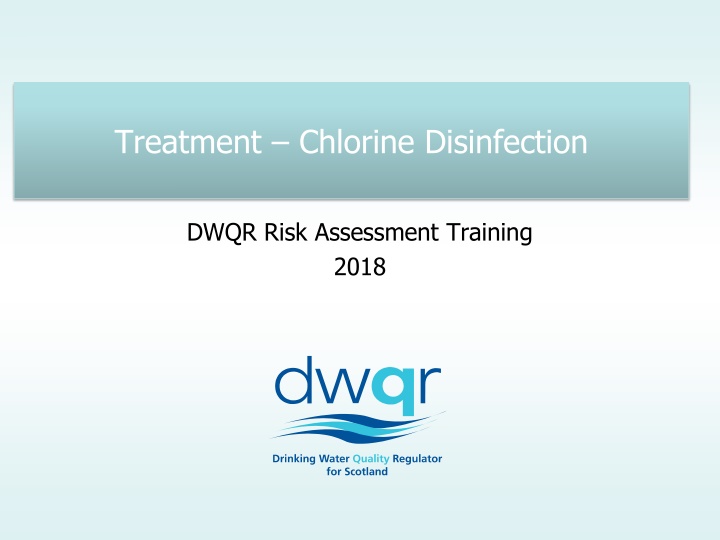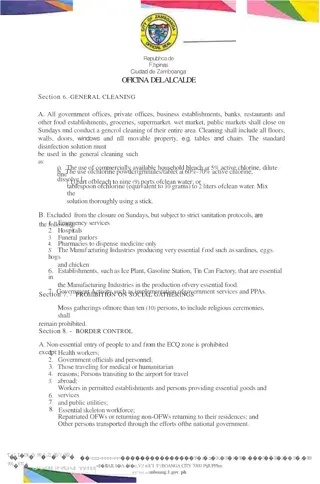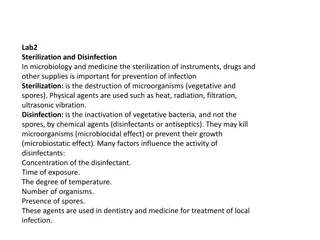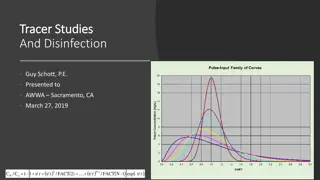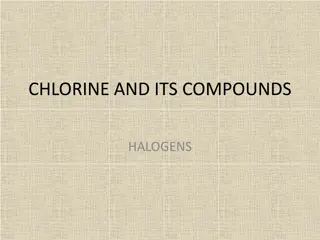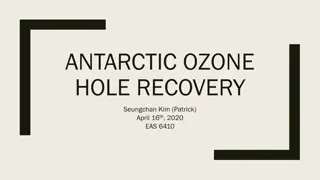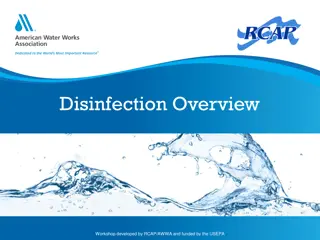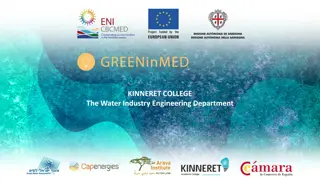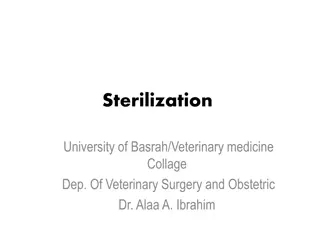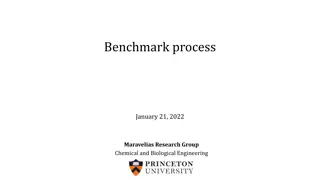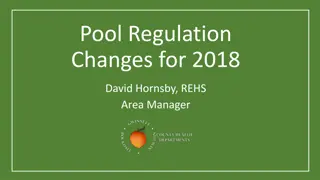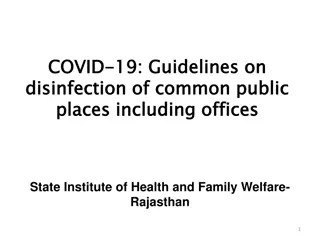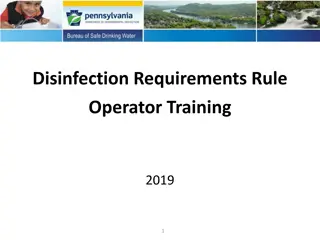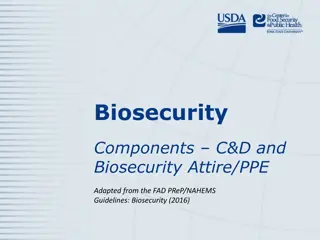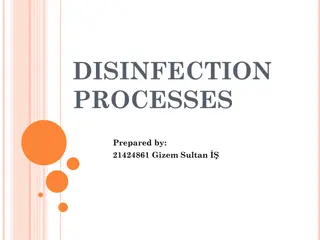Essential Guidelines for Chlorine Disinfection in Water Treatment
Learn about the usage and key points to watch for when implementing chlorine disinfection in water treatment processes. Understand the effectiveness, dosing methods, safety considerations, and monitoring protocols to ensure successful water disinfection. Proper handling of hypochlorite solution, monitoring residual levels, and maintaining equipment are crucial for efficient disinfection and water quality control.
Download Presentation

Please find below an Image/Link to download the presentation.
The content on the website is provided AS IS for your information and personal use only. It may not be sold, licensed, or shared on other websites without obtaining consent from the author.If you encounter any issues during the download, it is possible that the publisher has removed the file from their server.
You are allowed to download the files provided on this website for personal or commercial use, subject to the condition that they are used lawfully. All files are the property of their respective owners.
The content on the website is provided AS IS for your information and personal use only. It may not be sold, licensed, or shared on other websites without obtaining consent from the author.
E N D
Presentation Transcript
Treatment Chlorine Disinfection DWQR Risk Assessment Training 2018
Overview Traditional, established disinfectant Relatively cheap Usually dosed as liquid (sodium hypochlorite) Active disinfectant is hypochlorous acid (favoured form at low pH (<8)) Effective against bacteria, not Cryptosporidium Leaves a lasting residual in water Taste and by-products (THMs) can be an issue
Usage Chlorine needs time to react (contact tank or pipe typical time 30 mins) Typical residual; (after reaction) 0.2-0.5 mg/l Chlorine demand will vary with water quality (ideally automatically controlled) Dosing can be fixed, flow proportional or residual controlled (latter is best) Chlorine far less effective >pH8 (pH correct after disinfection) Chlorine residual may drop off in high residence time / low flow scenarios or where dirty pipes Possible to top up Cl in long systems (but consider by-products)
Usage Hypochlorite solution typically 14% by mass, but goes off with time (stock control) Health and safety considerations of handling Monitor at addition, after contact time and through system Many online monitors available, also portable test kits
Key Points to Watch For Is water clean (low turbidity?) How is dose set? (Consider CT (dose x time), residual at furthest point and by-products) Is mixing adequate? Have they measured contact time under all flows? Stock control of hypochlorite (max 6 months, out of light / heat) Hypochlorite suitable for water use (incl. low bromate) Procedure for making up solution Control of dosing (regularly checked) Monitors maintained and calibrated Spare parts (pumps, lines, injectors)
Key Points to Watch For They should be regularly checking & recording: Dose rate (pump settings) Hypochlorite solution concentration (or) Cl residual after dose (and at point of use) pH Equipment condition (pumps, hoses, injectors) If you find THMs: Check dose and residuals (too high?) Quality of incoming water (organics?) Residence times (tanks, large pipes) Any recirculation (multiple doses of chlorine)
Questions Automated chlorine dosing units may operate with a standby system in place, ensuring that chlorine continues to be dosed at the appropriate level if the main chlorination system fails (for example if the supply runs out, or a dosing line blocks). This will help ensure water is subject to disinfection at all times. TCL1 Could undisinfected water pass into supply? (Has the chlorine dosing system appropriate alarms or an automatic shutdown arrangement?) TCL2 Could lack of maintenance compromise the disinfection process? Refer to the maintenance regime recommended by the manufacturer and ask for written documentation that this is being adhered to, including servicing. Such documentation includes entries in a log book, diary records, and full records. TCL3 Is there a risk of loss of chlorine dosing going undetected due to lack of appropriate alarms and shutdowns? Is there a risk of contamination due to use of chemicals of inappropriate grade, i.e. not approved for use in drinking water supplies? Determine what alarms are in place to alert the operator to any loss of chlorine dosing, and whether this is linked to any automatic shut down of the supply to prevent undisinfected water entering the supply. TCL4 Chemicals used in a chlorination system must be approved for use with drinking water supplies and comply with Regulations. TCL5 Could disinfection be compromised due to incorrect storage of chemicals or excessive storage times? Hypochlorite storage should not exceed 6 months as its strength will reduce and there is an increasing risk of byproducts such as chlorate forming. Poor storage conditions can exacerbate this degradation or render the disinfectant ineffective. TCL6 Is there a possibility of incorrect making up / diluting of hypochlorite solution? Users should be aware of the strength of hypochlorite solution required and how this is made up. Clear instructions should be present on site and all chemicals and equipment should be clearly labelled. TCL7 Could there be confusion over the target chlorine residual (is it documented and appropriate?) The target chlorine residual should be set at an appropriate level and this must be clearly documented on site. TCL8 Is there a risk of poor control of disinfection due to lack of residual monitoring? Chlorine demand can vary rapidly, meaning that the amount of chlorine available to disinfect the water can change, putting effective disinfection at risk. It is important that chlorine residual is monitored regularly (ideally continuously via online monitors) and chlorine doses are adjusted accordingly. TCL9 Is there a risk of inadequate contact time under some flow conditions? Chlorine needs adequate contact time (Ct) with the water in order to disinfect effectively. A suitable contact tank or pipe should be present that ensures sufficient contact time at all flows (it may be necessary to restrict the maximum flow to enable this). Ct is a measure of disinfection and is calculated by multiplying the chlorine residual in mg/l by contact time in minutes. The appropriate Ct for a given system and water quality is best decided by an expert, but 10 is a reasonable minimum value for a good quality raw water. TCL10 Is there potential for by-product formation (primarily THMs?) Where waters are high in organic material and/or chlorine doses are poorly controlled or very high, disinfection by-products such as trihalomethanes may be formed. Formation of these can be controlled by improving removal of organics (colour) prior to chlorine addition, improving control of chlorine dosing and minimising water age.
